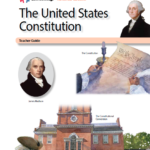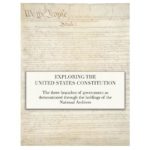Students who listen to this Grade 2 Core Knowledge History and Geography unit discover that Americans had a difficult task at hand after winning the Revolutionary War: they had to figure out a better way to govern themselves. Such leaders as James Madison, George Washington, Alexander Hamilton, and Benjamin Franklin traveled to Philadelphia to meet at the Constitutional Convention, with the goal of creating a new government. Students learn that the talks were held in secret in Independence Hall and that American leaders argued about many issues until they agreed to approve a new Constitution. They then hear that James Madison (whom we call the Father of the Constitution), along with John Jay and Alexander Hamilton, wrote the Federalist Papers to explain the document’s merits and to persuade the states to vote for it. Students find out that the states did finally approve the Constitution; that Madison wrote a Bill of Rights that was added to it; that the Constitution gives the American people the right to decide what the laws should be for our country; and that we can still amend it today.(5 lessons)
Constitution: Analyze – Explore – Music
Students will engage in a study of the Constitution to learn about the nature and structure of the United States. The Constitution will be analyzed and discussed as a primary source to understand the form of government and principles of the U.S. This lesson provides students an opportunity to explore how the government works and what the Constitution means to them today. Students will create a song to demonstrate understanding of the Constitution and nature of the U.S. government. Constituting America has a song contest teachers may want to integrate with this lesson plan.
The Supremacy Clause
Tension between the states and the federal government has been a constant throughout U.S. history. This video explores the supremacy clause in Article VI of the Constitution and key moments in the power struggle, including the landmark case McCulloch v. Maryland. In McCulloch, Chief Justice John Marshall wrote that the supremacy clause unequivocally states that the “Constitution, and the Laws of the United States … shall be the supreme Law of the Land.”
Civic Art Project: Notes on the Constitution
Students create art works based on an examination of the language of the Constitution and the personal connections they make. These art works will incorporate words, illustrations, and mixed media images.
This lesson can be adapted for different grade levels. High school students can use an abridged version of the U.S. Constitution. Elementary and middle school students can use the Preamble, or introduction, to the Constitution.
The Constitution
This series of videos breaks down the different parts of the United States Constitution for students. In the videos, Kim and Sal interview constitutional scholars associated with the National Constitution Center, including Jeffrey Rosen, Heather Gerken, Ilya Somin, and Richard Garnett.
Founding Documents: The Constitution Podcast
After just six years under the Articles of Confederation, a committee of anxious delegates agreed to meet in Philadelphia to amend the government. The country was in an economic crisis — citizens couldn’t pay their debts, the government couldn’t really collect taxes, and rebellions were cropping up in states across the nation. The existing government had the potential to drive the country to ruin. So fifty-five men gathered to determine the shape of the new United States.
The document that emerged after that summer of debate was littered with masterful planning, strange ideas and unsavory concessions. The delegates decided they’d be pleased if this new government lasted fifty years. It has been our blueprint for over two centuries now. This is the story of how our Constitution came to be.
This short episode includes a one-page Graphic Organizer for students to take notes on while listening, as well as discussion questions on the back side.
The Appointment of Sandra Day O’Connor
The U.S. Constitution grants the President the power to appoint people to a variety of government positions. These appointments require careful thought and consideration since the people can have a great impact on the lives of many Americans during that President’s term. Some appointments need even greater thought and consideration, and those are to the federal judicial system and more importantly, to the Supreme Court of the United States. Justices of the Supreme Court (and other federal courts) serve lifetime appointments. Their rulings as they interpret the Constitution, and other situations as outlined in Article III of the Constitution, can have far-reaching effects for generations. With this awesome power to appoint comes an equally awesome responsibility to make sure that the individuals are the best people for the job. In this lesson, students will examine the appointment of Supreme Court Justice Sandra Day O’Connor, who was also the first female Justice. Students will examine the process by which a President makes the selection and the steps that lead to that person being confirmed by the Senate (or not).
The United States Constitution (CKHG Unit)

This unit explores the creation and central ideas of the United States Constitution. Across 18 lessons, students learn how, after the Revolution, the Founding Fathers worked to confront the shortcomings of the Articles of Confederation. They learn why the Bill of Rights was added to the Constitution, and explore reasons why the Constitution has survived as the guiding document of government in the United States.
Exploring the United States Constitution eBook

Each chapter connects one or more of the billions of primary source documents in the holdings of the National Archives to the principles found in the United States Constitution. These documents exemplify the workings of the three branches of the federal government as laid out in our Constitution. This eBook is available as a Multi-Touch book for iPad and Mac on iTunes, or for PC, Android devices, Mac, iPhone, iPad, or eReader with Scribd.
The Constitution in Today’s America
This lesson will teach students about the development of the U.S. Constitution and its role in our system of government. Students will learn about the relationship between the Constitution and a democratic government. In the activities and lesson extensions, they will explore decisions made in the Constitution, including the creation of government institutions, and the purpose of the amendment process. Students also will write an essay in which they analyze how the Constitution helped to fulfill the promise of the United States.